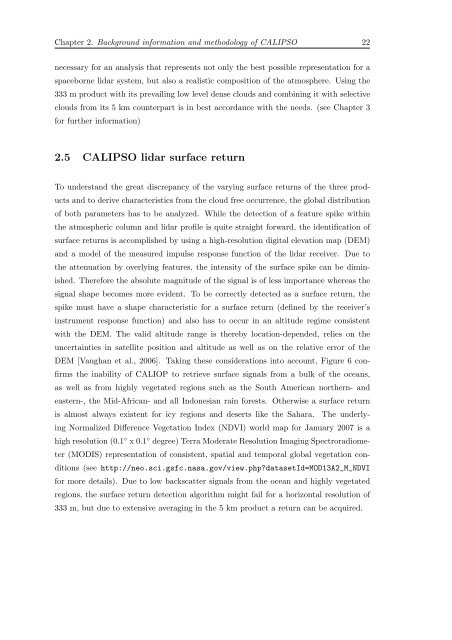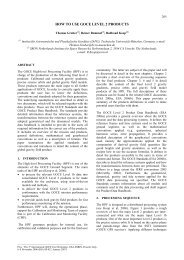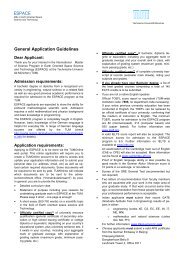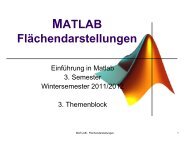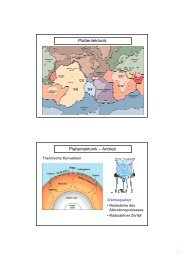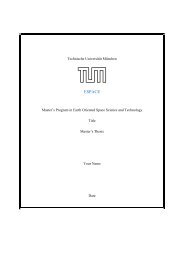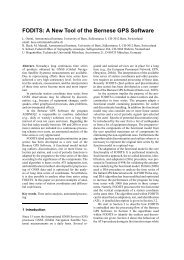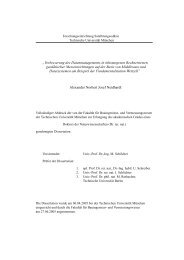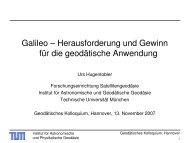Cloud Statistics from Calipso Lidar Data for the ... - espace-tum.de
Cloud Statistics from Calipso Lidar Data for the ... - espace-tum.de
Cloud Statistics from Calipso Lidar Data for the ... - espace-tum.de
Create successful ePaper yourself
Turn your PDF publications into a flip-book with our unique Google optimized e-Paper software.
Chapter 2. Background in<strong>for</strong>mation and methodology of CALIPSO 22<br />
necessary <strong>for</strong> an analysis that represents not only <strong>the</strong> best possible representation <strong>for</strong> a<br />
spaceborne lidar system, but also a realistic composition of <strong>the</strong> atmosphere. Using <strong>the</strong><br />
333 m product with its prevailing low level <strong>de</strong>nse clouds and combining it with selective<br />
clouds <strong>from</strong> its 5 km counterpart is in best accordance with <strong>the</strong> needs. (see Chapter 3<br />
<strong>for</strong> fur<strong>the</strong>r in<strong>for</strong>mation)<br />
2.5 CALIPSO lidar surface return<br />
To un<strong>de</strong>rstand <strong>the</strong> great discrepancy of <strong>the</strong> varying surface returns of <strong>the</strong> three products<br />
and to <strong>de</strong>rive characteristics <strong>from</strong> <strong>the</strong> cloud free occurrence, <strong>the</strong> global distribution<br />
of both parameters has to be analyzed. While <strong>the</strong> <strong>de</strong>tection of a feature spike within<br />
<strong>the</strong> atmospheric column and lidar profile is quite straight <strong>for</strong>ward, <strong>the</strong> i<strong>de</strong>ntification of<br />
surface returns is accomplished by using a high-resolution digital elevation map (DEM)<br />
and a mo<strong>de</strong>l of <strong>the</strong> measured impulse response function of <strong>the</strong> lidar receiver. Due to<br />
<strong>the</strong> attenuation by overlying features, <strong>the</strong> intensity of <strong>the</strong> surface spike can be diminished.<br />
There<strong>for</strong>e <strong>the</strong> absolute magnitu<strong>de</strong> of <strong>the</strong> signal is of less importance whereas <strong>the</strong><br />
signal shape becomes more evi<strong>de</strong>nt. To be correctly <strong>de</strong>tected as a surface return, <strong>the</strong><br />
spike must have a shape characteristic <strong>for</strong> a surface return (<strong>de</strong>fined by <strong>the</strong> receiver’s<br />
instrument response function) and also has to occur in an altitu<strong>de</strong> regime consistent<br />
with <strong>the</strong> DEM. The valid altitu<strong>de</strong> range is <strong>the</strong>reby location-<strong>de</strong>pen<strong>de</strong>d, relies on <strong>the</strong><br />
uncertainties in satellite position and altitu<strong>de</strong> as well as on <strong>the</strong> relative error of <strong>the</strong><br />
DEM [Vaughan et al., 2006]. Taking <strong>the</strong>se consi<strong>de</strong>rations into account, Figure 6 confirms<br />
<strong>the</strong> inability of CALIOP to retrieve surface signals <strong>from</strong> a bulk of <strong>the</strong> oceans,<br />
as well as <strong>from</strong> highly vegetated regions such as <strong>the</strong> South American nor<strong>the</strong>rn- and<br />
eastern-, <strong>the</strong> Mid-African- and all Indonesian rain <strong>for</strong>ests. O<strong>the</strong>rwise a surface return<br />
is almost always existent <strong>for</strong> icy regions and <strong>de</strong>serts like <strong>the</strong> Sahara. The un<strong>de</strong>rlying<br />
Normalized Difference Vegetation In<strong>de</strong>x (NDVI) world map <strong>for</strong> January 2007 is a<br />
high resolution (0.1 ◦ x 0.1 ◦ <strong>de</strong>gree) Terra Mo<strong>de</strong>rate Resolution Imaging Spectroradiometer<br />
(MODIS) representation of consistent, spatial and temporal global vegetation conditions<br />
(see http://neo.sci.gsfc.nasa.gov/view.php?datasetId=MOD13A2_M_NDVI<br />
<strong>for</strong> more <strong>de</strong>tails). Due to low backscatter signals <strong>from</strong> <strong>the</strong> ocean and highly vegetated<br />
regions, <strong>the</strong> surface return <strong>de</strong>tection algorithm might fail <strong>for</strong> a horizontal resolution of<br />
333 m, but due to extensive averaging in <strong>the</strong> 5 km product a return can be acquired.


